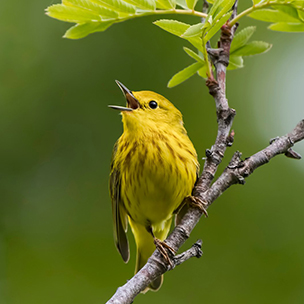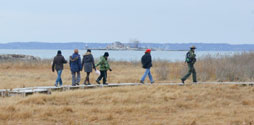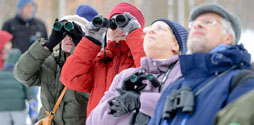Birding at NYC Parks

New York City is situated on what is known as the Atlantic Flyway, a geographical group of migratory paths that many species of birds follow during spring and fall migration. Some birds make epic journeys, from as far north as the Arctic, all the way to Central and South America.
As they follow the coast, many birds look for landmarks to guide their way. Imagine you were a bird flying over Manhattan, and you have three thoughts on your mind: food, water, and shelter. As you fly over the concrete and steel in New York City, you will notice little green islands. Those are our parks! And those are the best places for birds to take a break, and for park patrons and birders alike to enjoy them.
Here are some of the best places to go birding at Parks:
Bronx
Van Cortlandt Park
Van Cortlandt Park’s 1,146 acres are home to about 230 species of birds. Enter the park at West 242nd Street to journey through the park’s lake area and freshwater wetlands on one of the park’s most popular birding trails, the 1.25-mile John Kieran Nature Trail. Find mallard and wood ducks by the Van Cortlandt Lake, as well as red-winged blackbirds and great egrets flocking among the reed.
West of the trail and lake is the Parade Ground and Vault Hill, a known destination for spotting hawks and other birds of prey during the fall.
Keep north and connect to the Putnam Trail, which stretches along Tibbets Brook, a quiet stream and must-see area for birders, who can occasionally spot herons, owls, and woodpeckers here.
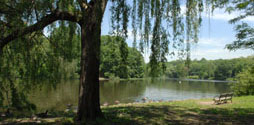
Van Cortlandt Lake
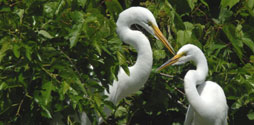
Great Egret
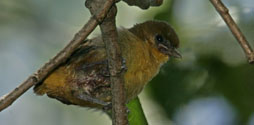
Baltimore Oriole chick
Take the John Muir Nature Trail east through the Croton Woods and the Northeast Forest. During the spring, you can spot woodpeckers, warblers, wood thrush, wrens, flycatchers, and the Baltimore oriole among the oak and sweet gum forests.
View a map of Van Cortlandt Park's hiking trails
More information about Van Cortlandt Park
Pelham Bay Park
Pelham Bay Park is New York City’s largest park and is best known for spotting owls and ospreys. For some of the best viewing spots, head to Orchard Beach and head west on the Kazimiroff Trail through the 189-acre Hunter Island, which was declared a Marine Zoology and Geology Sanctuary. You can see great horned owls in the tall Norway spruce and the white pines. Other owl species like the northern saw-whets and barred owls have also been spotted here in the highest points of the park’s oldest and largest continuous oak forest.
Head east from Orchard Beach through the Twin Island Preserve trail to the 20,000-year-old bedrock shoreline for a breathtaking view and to spot songbirds and waterfowl in the Long Island Sound and salt marsh. During low tide, you can reach the Twin Islands, a 19-acre natural area that was once used by the Siwanoy tribe for hunting, fishing, and collecting wampum. Here, you can spot migratory birds like the black-crowned night heron, the little blue heron, yellow-crowned night herons, the great egret, cattle egret, snowy egret, and the glossy ibis.
Head south of Orchard Beach to The Meadow, a 25-acre grassland and open field, that is home to the ring-necked pheasant and the common American woodcock.

Hunter Island

Great Horned Owl
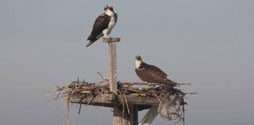
Ospreys
Stop by Bartow-Pell Mansion, and take the Siwanoy Trail along The Lagoon, east of the mansion. This area is frequented by wading birds, such as egrets and herons, and shorebirds, such as willets and killdeer. The great blue heron and snowy egrets can be spotted in the tidal waters. They stand motionless on stilt-like legs, patiently awaiting their prey, and then lunge at the fish with a quick stab of their long, spear-like bills. The migrating ospreys soar 40 feet above the surface and plunge into the water to dive for fish.
Circle back west to Shore Road and continue south on the trail to the central woods, enclosed by Bartow Circle to the west, Orchard Beach Road to the north, City Island Road to the south, the Putnam Bridge/Shore Road to the west, and Park Drive to the east. Here, you can spot egrets, hawks, and ibis during fall migration.
Our Urban Park Rangers also lead occasional special programs to look for birds of prey at the closed Pelham Landfill.
View a map of Pelham Bay Park's hiking trails
More information about Pelham Bay Park
Owls
Our parks offer the perfect opportunities for spotting owls in our parks' highest points and tallest trees during the fall and winter. Barred owls, northern saw-whet owls (pictured here), and great-horned owls are popular in the Bronx's Pelham Bay Park. Barred Owls have dark barred stripes across white plumage and sound like they're shouting "Who cooks for you?". Great horned owls start nesting early in the year. They incubate in tree cavities in January and raise owlets in the dead of winter. Northern saw-whet owls are the smallest and, some say, cutest owl species found in the northeast. They're only six to eight inches tall, with speckled brown plumage.
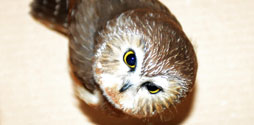
Brooklyn
Prospect Park
In Brooklyn, Prospect Park is a great place to see more than 200 species of birds that fly through the 526-acre park throughout the year. The park is also home to the nation’s first urban Audubon Center (at the Boathouse), which offers hands-on exhibits and birding programs for children and adults. The Prospect Park Alliance boasts birders having spotted the pied-billed grebe, the American bittern, the saw-whet owl, and the great-horned owl, among its more popular visitors like the green heron, the red-tailed hawk, and 18 duck species.

The Boathouse
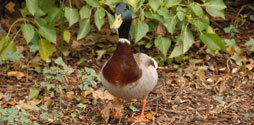
Mallard Duck
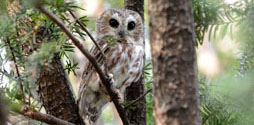
Saw-Whet Owl
Stay in the park’s southeast area to traverse key birding spots: The Ravine, The Pools, Lullwater, Prospect Park Lake, and Lookout Hill, the highest point in the park. View a map of key birding spots in Prospect Park
More information about Prospect Park
Marine Park
Marine Park, Brooklyn’s largest park, is a favorite among locals and experts alike to go birding. Located on the eastern coastline, and neighboring the Jamaica Bay Wildlife Refuge, the park’s 798 acres of marshes and coastline are home to a large variety of waterfowl, ospreys looking to mate during the summertime, and more than 300 other species of birds frequenting the area.
Swing by Gerritsen Creek, a freshwater creek and the home of the country’s first tide-powered mill. The creek provides a natural habitat for a diverse group of birds like myrtle warblers, Canada geese, brants, canvasbacks, buffleheads, red-breasted mergansers, common loons, grasshopper sparrows, and ring-necked pheasants, as well as shorebirds, such as cormorants and American oystercatchers frequenting the Jamaica Bay area.
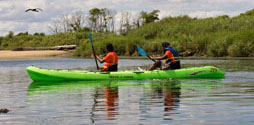
White Island
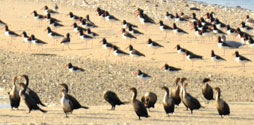
Cormorants in front of American Oyster Catchers
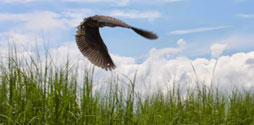
Yellow-crowned Heron
During the summer, our Urban Park Rangers host birding trips by canoe to White Island, a natural area in the creek, perfect for spotting herons and egrets. From June through August, clapper rails, which are grayish-brown birds with a downward bill, can be heard calling throughout the salt marsh. In winter, freshwater and marine waterfowl find shelter in the creek. Winter visitors include greater and lesser scaups, ruddy ducks, mute swans, Canada geese, and loons.
View a map of Marine Park's hiking trails
More information about Marine Park
Ospreys
Ospreys are one of nature’s most skillful hunters. These majestic birds can plummet from about 150 feet in the air and execute dramatic dives into the water to catch live fish. They are distinguishable by their brown backs, wings, and tails, white undersides, and distinctive brown stripe running across their heads. Ospreys mate for life. In 2014, there were 20 known couples in the Jamaica Bay Area. Like most predators, female ospreys are larger than males. A female’s wingspan can reach five feet, while a male’s approaches four feet.
These large birds also build large nests: at least three feet deep and five feet wide, and are known to nest in both natural areas, such as trees, and man-made ones, such as light-posts and utility poles. Looking for ospreys elsewhere? Try Hunter’s Island and the Lagoon in Pelham Pay Park.

Manhattan
Central Park
Some of the most popular birding spots in NYC are in Central Park. About 230 species of birds can be spotted here throughout the year. Probably the most famous birding spot in the city is The Ramble, a 36-acre wild garden located mid-park between 74th and 79th Streets. Throughout the year, and especially in May, this is an excellent place to find songbirds. The North Woods of Central Park is also popular for spotting songbirds and a variety of owls, such as barred, great horned, and saw-whet owls.
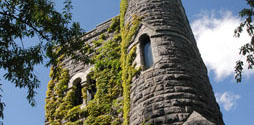
Belvedere Castle

Yellow Warbler
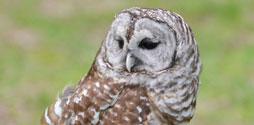
Barred Owl
Visit Belvedere Castle, which features the highest views of the city, in the fall to see hawks on its upper terraces. Central Park hosts many birding events year-round, but if you’re looking to go birding in the 843-acre park on your own, head to the castle to borrow a free Discovery Kit, which contains binoculars, a guidebook, maps, and sketching materials.
More information about Central Park
Northern Manhattan Parks
The variety of park terrain in this section of the city offers great viewing spots for birds flying through New York City.
Inwood Hill Park, home to Manhattan’s last forest and only salt marsh, is popular for spotting a variety of songbirds, as well as belted kingfishers, screech owls, and barred owls. Muscota Marsh, on its northern tip, is both a salt and fresh water marsh welcoming the great blue heron and the snowy egret. In the wintertime, our Urban Park Rangers host bald eagle watch events in the park. Because of the park's forested area and location on the shores of the Hudson River, the park is an ideal spot for discovering bald eagles soaring our skies.
More information about Inwood Hill Park
Fort Tryon Park’s elevated views of the Hudson and the Palisades are perfect for spotting birds, especially woodpeckers hanging around the trees in the 67-acre park. Its Heather Garden is New York City’s largest public garden with unrestricted access, and it is frequented by a variety of songbirds come spring and summer.
More information about Fort Tryon Park
On the east side, Highbridge Park’s winding trails, oak-hickory forests, and elevated park areas, provide some of the best spots for hawk watching during spring and fall migration.
More information about Highbridge Park
Head to Fort Washington Park during the fall to spot peregrine falcons hanging out under the George Washington Bridge.
More information about Fort Washington Park
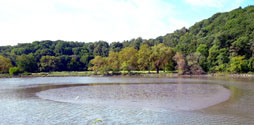
Inwood Hill Park
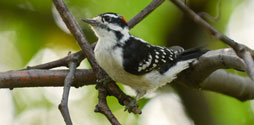
Downy Woodpecker
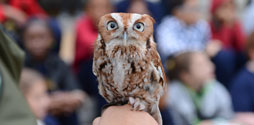
Screech Owl
Peregrine Falcons
One of nature’s most skilled hunters, the peregrine falcon dive-bombs its prey at speeds of up to 200 miles per hour. Capable of flying at speeds of up to 60 miles per hour in level flight, the peregrine is one of the world’s fastest birds. When the Endangered Species Act was passed in 1973, peregrine falcons were one of the first species to receive protection. Restoration efforts were launched throughout the 1970s and 1980s; during that time, 150 young captivity-bred Peale’s peregrine falcons (the eastern peregrine subspecies being extinct) were released in New York State, to reclaim nesting sites in the rocky peaks and crags of the Adirondacks and Hudson River Palisades. By 1999, the peregrine falcon had recovered sufficiently to be moved off the Endangered Species List.
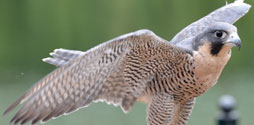
Queens
Highland Park
Birders who visit Highland Park, which sits on the border of Queens and Brooklyn, boast of having spotted more than 150 species of birds throughout the year. During the fall, Highland Park’s restored Ridgewood Reservoir is a key place for spotting falcons, eagles, and other birds of prey. For the best views, take the Ridgewood Reservoir trail, a hidden secret among birders, between the reservoir’s basin 1 and basin 2. Walk this trail come spring to spot songbirds frequenting the park’s most calming scene.
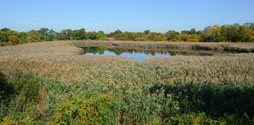
Ridgewood Reservoir
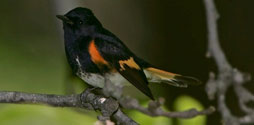
American Redstart
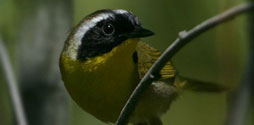
Common Yellowthroat
Enter the park at Highland Boulevard and Heath Place or near Jackie Robinson Parkway and Bulwer Place and head east on the footpath. You will come across a wetland area under the stone bridge, birders frequent this area during spring migration to spot warblers.
More information about Highland Park
Forest Park
Trek over to Forest Park, Highland Park’s neighbor and the home of Queens’ largest continuous oak forest. The harbor hill moraine and the park’s susceptibility to the northwest winds bring in many hawks during the fall migration. To spot these raptors, take the Blue or Yellow Trails through the woodlands on the east side of the park, accessible by Forest Park Drive.
One of the most popular birding spots is Strack Pond, located at Woodhaven Boulevard and Forest Park Drive. This is a key spot for seeing warblers in the park during spring migration.
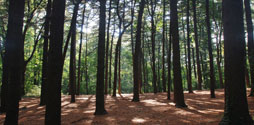
Forest Park
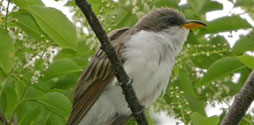
Yellow-Billed Cuckoo
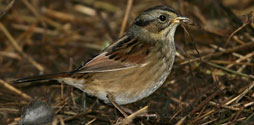
Swamp Sparrow
Other common birds spotted in Forest and Highland Parks include: red-tailed hawks, woodpeckers, the great blue herons, mallards, northern orioles, American kestrels, ruby-throated hummingbirds, ring-necked pheasants, common flickers, eastern pewees, the tufted titmouse, white-breasted nuthatches, wood thrushes, the red-eyed vireo, red-winged blackbirds, scarlet tanagers, the rufous-sided towhee, and sparrows.
View a birding map of Forest Park
View a map of Forest Park's hiking trails
More information about Forest Park
Rockaway Beach
Rockaway Beach is home to the endangered piping plover, as well as a large variety of interesting waterfowl, and other shorebirds like the loon and the popular seagull.
During the winter, you may be able to spot snowy owls hanging out around the beach area.
More information about Rockaway Beach
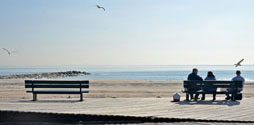
Rockaway Beach and Boardwalk
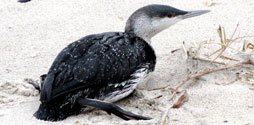
Loon
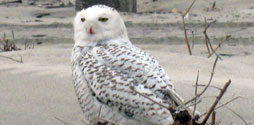
Snowy Owl
Piping Plovers
The piping plover is a small, plump shorebird that breeds on Atlantic beaches from Newfoundland to Virginia, as well as on inland beaches from eastern Alberta and Nebraska east to the shores of Lake Ontario. In 1986, the piping plover was federally designated as endangered on the Great Lakes and threatened on the Atlantic Coast. Plovers nest annually on Rockaway Beach in Queens.
NYC Parks' Wildlife Unit monitors the plovers on Rockaway Beach according to the guidelines provided by the U.S. Fish & Wildlife Service. Nests are observed at least three times a week, and records are kept regarding the number of plovers observed, the number of nesting pairs, and the number of eggs in a clutch. Observations are usually made from afar using binoculars and spotting scopes so as not to disturb the nesting plovers.
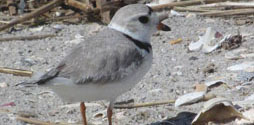
Staten Island
Clove Lakes Park
Staten Island, with its abundant green space, has many great birding spots. Clove Lakes Park’s 193 acres of natural preserves and freshwater wetlands provide resting, breeding, and feeding grounds for many birds during the spring and fall migration. Enter the park at Martling Avenue and head east through the hiking trail to the heart of the park.
Hawks, cardinals, woodpeckers, red-eyed vireos, and white-breasted nuthatches live in the shady woodland hillsides along the trail. Though Clove Lake is the most popular waterside spot, the quieter Brooks Lake and Martling Pond are better suited for spotting the smaller birds. Spot Canada geese, mallards, and numerous gulls, such as ring-billed and herring frequenting the lakes. The freshwater wetlands also welcome red-winged blackbirds and yellow warblers to the area.
More information about Clove Lakes Park
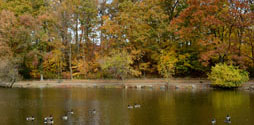
Martling Lake
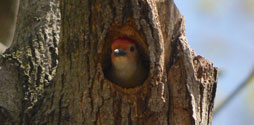
Red-bellied Woodpecker
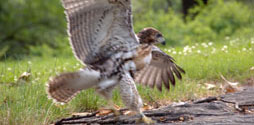
Red-Tailed Hawk
The Greenbelt
The Greenbelt is a group of parks and natural areas in the heart of Staten Island.
Take the blue or red trail to Walker Pond and Loosestrife Swamp in High Rock Park. Both of these spots provide excellent views for waterfowl. Look for egrets, herons, ducks, kingfishers, and migrating warblers.
If you’re looking for birds of prey during spring and fall migration, head to the 200-foot-tall Moses Mountain (enter at the north corner of Rockland Avenue and Meisner Avenue and take the yellow trail) to see ospreys, red-tailed hawks, sharp-shined hawks, and cooper’s hawks. If you are lucky, you might spot a bald eagle!
Buttonbus Swamp, which is accessible from the Greenbelt Nature Center (700 Rockland Avenue), welcomes woodpeckers, blue jays, black-capped chickadees, and, sometimes, the screech owl can be seen here.
More information about the Greenbelt
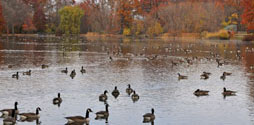
Willowbrook Park
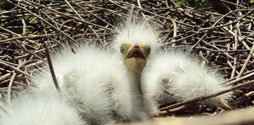
Great Egret
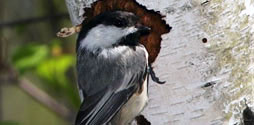
Black-Capped Chickadee
Raptors
Fall migration is the perfect time of year for spotting raptors - birds of prey such as, hawks, falcons, owls, and eagles that search our parks for food. Raptors live in some of the highest points of our parks, especially in Freshkills Park, a developing 2,200 acre park set to open completely in 2036. Bald eagles have been spotted in Queens and Staten Island parks this fall. Other key places to spot raptors include Staten Island's Paulo's Peak; Queens’ Forest Park and Alley Pond Park; Belvedere Castle, Fort Tryon Park, and Highbridge Park in Manhattan; and Pelham Bay Park the Bronx. September through November are peak times to see ospreys, broad wings, and eagles. See the sharp-shinned and cooper’s hawks throughout the fall until November.
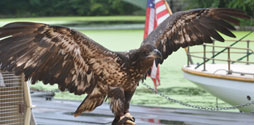 Bald Eagle
Bald Eagle
How to Watch Birds Safely
In order to make sure that birds are safe in their visits to NYC, it’s important to make sure that you follow a few basic guidelines when you’re watching them.
- Observe and enjoy birds from a distance.
- Avoid stressing birds or exposing them to danger. Exercise restraint when observing or photographing them.
- Stay on park trails and paths. Do not damage plants or wildlife habitat.
- Follow all NYC Parks Rules and Regulations and obey the instructions of Parks workers.
Our hiking trails pass through most of the key places for spotting birds in New York City parks throughout the year. Pick a park and trail to explore the outdoors.
Join our Urban Park Rangers and the New York City Audubon on birding trips around the city throughout the year.
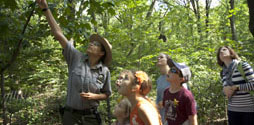
Life List
What’s on your life list? Birders gather a life list; this is a listing of birds they have seen, where they have seen them, and when they saw them. Many birds spend their lives filling up their life list. Are you looking for a particular bird in New York City? Tweet us at @NYCParks, and we’ll help you! Or, visit the New York City Audubon’s website for more information.
